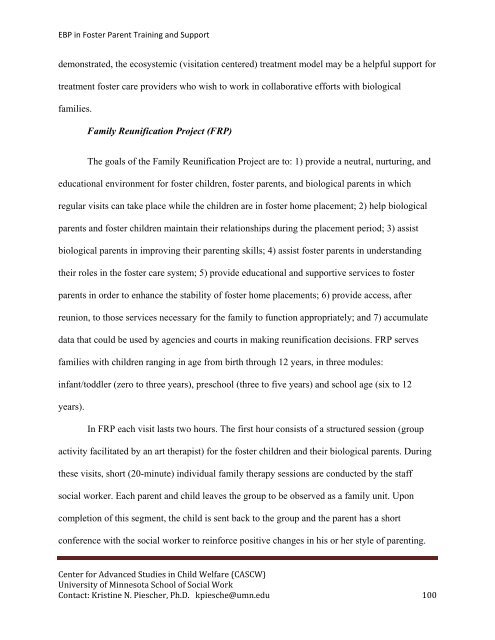Evidence-Based Practice in Foster Parent Training and Support ...
Evidence-Based Practice in Foster Parent Training and Support ...
Evidence-Based Practice in Foster Parent Training and Support ...
Create successful ePaper yourself
Turn your PDF publications into a flip-book with our unique Google optimized e-Paper software.
EBP <strong>in</strong> <strong>Foster</strong> <strong>Parent</strong> Tra<strong>in</strong><strong>in</strong>g <strong>and</strong> <strong>Support</strong>demonstrated, the ecosystemic (visitation centered) treatment model may be a helpful support fortreatment foster care providers who wish to work <strong>in</strong> collaborative efforts with biologicalfamilies.Family Reunification Project (FRP)The goals of the Family Reunification Project are to: 1) provide a neutral, nurtur<strong>in</strong>g, <strong>and</strong>educational environment for foster children, foster parents, <strong>and</strong> biological parents <strong>in</strong> whichregular visits can take place while the children are <strong>in</strong> foster home placement; 2) help biologicalparents <strong>and</strong> foster children ma<strong>in</strong>ta<strong>in</strong> their relationships dur<strong>in</strong>g the placement period; 3) assistbiological parents <strong>in</strong> improv<strong>in</strong>g their parent<strong>in</strong>g skills; 4) assist foster parents <strong>in</strong> underst<strong>and</strong><strong>in</strong>gtheir roles <strong>in</strong> the foster care system; 5) provide educational <strong>and</strong> supportive services to fosterparents <strong>in</strong> order to enhance the stability of foster home placements; 6) provide access, afterreunion, to those services necessary for the family to function appropriately; <strong>and</strong> 7) accumulatedata that could be used by agencies <strong>and</strong> courts <strong>in</strong> mak<strong>in</strong>g reunification decisions. FRP servesfamilies with children rang<strong>in</strong>g <strong>in</strong> age from birth through 12 years, <strong>in</strong> three modules:<strong>in</strong>fant/toddler (zero to three years), preschool (three to five years) <strong>and</strong> school age (six to 12years).In FRP each visit lasts two hours. The first hour consists of a structured session (groupactivity facilitated by an art therapist) for the foster children <strong>and</strong> their biological parents. Dur<strong>in</strong>gthese visits, short (20-m<strong>in</strong>ute) <strong>in</strong>dividual family therapy sessions are conducted by the staffsocial worker. Each parent <strong>and</strong> child leaves the group to be observed as a family unit. Uponcompletion of this segment, the child is sent back to the group <strong>and</strong> the parent has a shortconference with the social worker to re<strong>in</strong>force positive changes <strong>in</strong> his or her style of parent<strong>in</strong>g.Center for Advanced Studies <strong>in</strong> Child Welfare (CASCW)University of M<strong>in</strong>nesota School of Social WorkContact: Krist<strong>in</strong>e N. Piescher, Ph.D. kpiesche@umn.edu 100
















